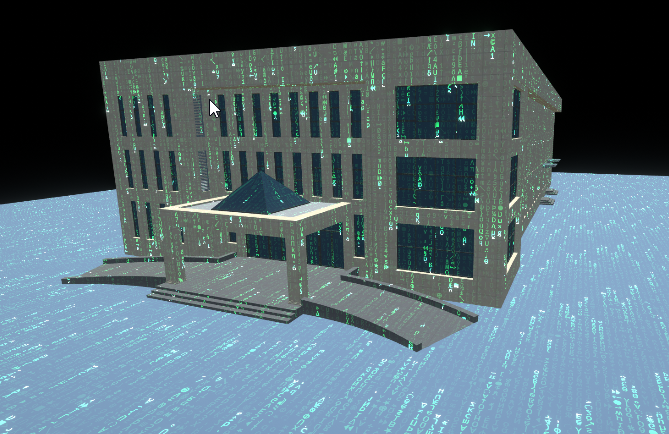文章目录[x]
- 0.1:文字的随机变化
- 0.2:下雨的矩形列
- 1:应用到场景中
黑客帝国的数字雨特效令印象深刻,网上(GitHub)已经有人在Unity中实现了类似的效果:

一、2D效果的实现
这个2D的效果主要由两部分组成,一是随机变化的文字,二是如同下雨一样的矩形列。
文字的随机变化
我们先来看如何实现随机变化的文字。
准备一张1024 x 1024大小的文字贴图,r通道包含了将要用于随机显示的16行 x 16列的文字信息:
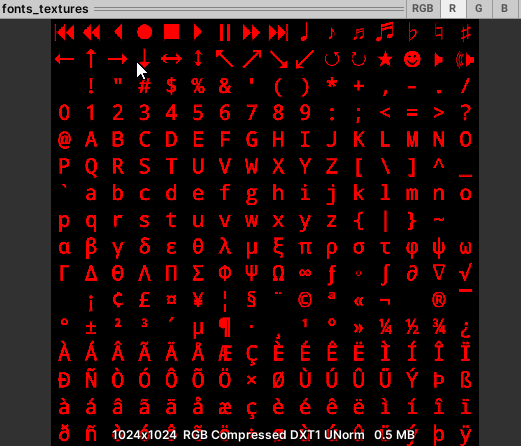
我们使用compute shader生成一张白噪声RT来达到随机的目的:
// Each #kernel tells which function to compile; you can have many kernels
#pragma kernel Generate_White_Noise
// The below macro is used to get a random number which varies across different generations.
#define rnd(seed, constant) wang_rnd(seed +triple32(_session_rand_seed) * constant)
uint triple32(uint x)
{
x ^= x >> 17;
x *= 0xed5ad4bbU;
x ^= x >> 11;
x *= 0xac4c1b51U;
x ^= x >> 15;
x *= 0x31848babU;
x ^= x >> 14;
return x;
}
float wang_rnd(uint seed)
{
uint rndint = triple32(seed);
return ((float)rndint) / float(0xFFFFFFFF); // 0xFFFFFFFF is max unsigned integer in hexa decimal
}
// Create a RenderTexture with enableRandomWrite flag and set it
// with cs.SetTexture
RWTexture2D<float4> _white_noise;
uint _session_rand_seed;
#define image_dimension 512
[numthreads(8,8,1)] // 16 in 16 image.
void Generate_White_Noise(uint3 id : SV_DispatchThreadID)
{
uint pixel_unique_id = id.x + id.y * image_dimension;
float rand_x = rnd(pixel_unique_id, 1);
float rand_y = rnd(pixel_unique_id, 861);
_white_noise[id.xy] = float4(rand_x, rand_y, 0.0, 0.0);
}
我们每隔一段时间就改变一次随机数种子来输出变化的白噪声贴图:
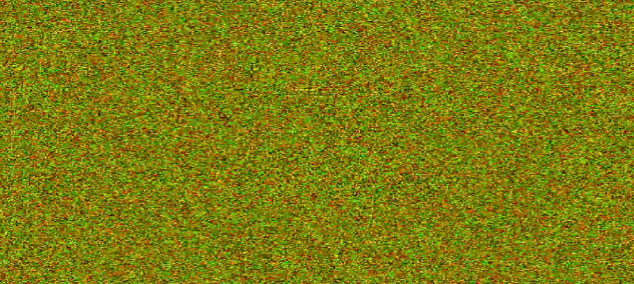
随后我们在绘制屏幕时使用白噪声贴图来采样我们的文本贴图:
Shader "Unlit/ScreenSpaceMatrixEffect"
{
SubShader
{
Tags { "RenderType"="Opaque" }
LOD 100
Pass
{
CGPROGRAM
#pragma vertex vert
#pragma fragment frag
#include "UnityCG.cginc"
struct appdata
{
float4 vertex : POSITION;
float2 uv : TEXCOORD0;
};
struct v2f
{
float2 uv : TEXCOORD0;
float4 vertex : SV_POSITION;
};
uint _screen_width;
uint _screen_height;
sampler2D _white_noise;
sampler2D _font_texture;
v2f vert (appdata v)
{
v2f o;
o.vertex = UnityObjectToClipPos(v.vertex);
o.uv = v.uv;
return o;
}
float text(float2 coord)
{
float2 uv = frac (coord.xy/ 16.); // 获取当前block的uv
float2 block = floor(coord.xy/ 16.); // 获取当前block的ID. 左下角是(0,0),右上角是(15,15)
uv = uv * 0.7 + .1; // 做点缩放让字符更大
float2 rand = tex2D(_white_noise, // 从变化的白噪声贴图中获取随机值
block.xy/float2(512.,512.)).xy; // 512 是白噪声贴图的宽度. 除以宽度让每个block对应噪声贴图的一个像素
rand = floor(rand*16.); // 每个随机值被用于在16列的font_texture中采样
uv += rand; // 让uv做随机偏移
uv *= 0.0625; // 将uv从0-16. 映射成0到1,以便从font_texture中采样
uv.x = -uv.x;
return tex2D(_font_texture, uv).r;
}
#define scale 0.6
fixed4 frag (v2f i) : SV_Target
{
fixed4 col = float4(0.,0.,0.,1.);
col.xyz = text(i.uv * float2(_screen_width, _screen_height)*scale);
return col;
}
ENDCG
}
}
}
最后得到文本随机变化的效果:
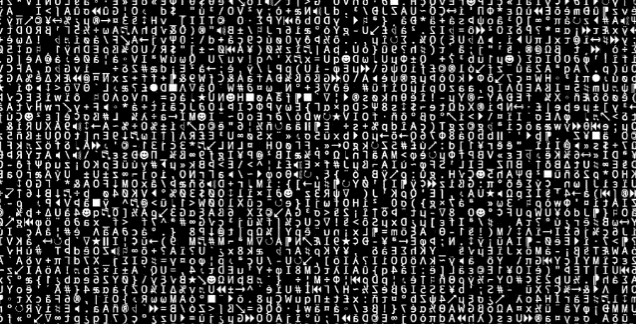
下雨的矩形列
float3 rain(float2 fragCoord)
{
fragCoord.x = floor(fragCoord.x/ 16.); // 得到列号
float offset = sin (fragCoord.x*15.); // 每一列雨柱需要有不同的起点,对列号取sin值作为偏移
float speed = cos (fragCoord.x*3.)*.15 + .35; // 列号取cos值得到不同的速度.加上0.35保证是正数
float y = frac((fragCoord.y / _screen_height) // 这一行让y映射成0到1
+ _Time.y * speed + offset); // 给y加上不同的速度和偏移
return float3(.1, 1., .35) / (y*20.); // y值越大越暗
}
#define scale 0.6
fixed4 frag (v2f i) : SV_Target
{
fixed4 col = float4(0.,0.,0.,1.);
col.xyz = rain(i.uv * float2(_screen_width, _screen_height)*scale);
return col;
}
雨的效果比较简单,就是自上而下颜色越来越亮,再水平分列,给每一列不同的偏移和速度就行了。这是只有雨柱的效果:
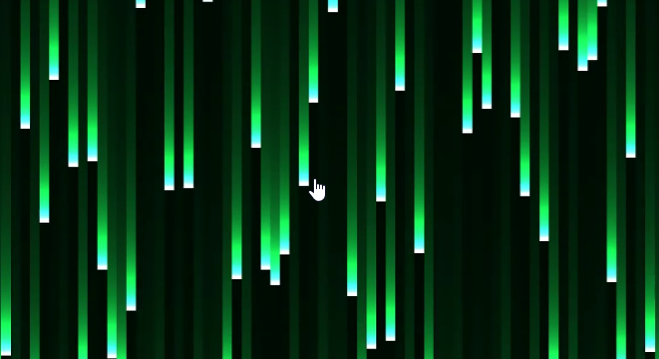
最后我们把文本变化和雨柱效果相乘,就是2D的数字雨效果了。
fixed4 frag (v2f i) : SV_Target
{
fixed4 col = float4(0.,0.,0.,1.);
col.xyz = text(i.uv * float2(_screen_width, _screen_height)*scale)*rain(i.uv * float2(_screen_width, _screen_height)*scale);
return col;
}
应用到场景中
我们如何让数字雨沿着场景模型流动呢?这里需要用到triplaner mapping三平面映射的技术。简单来说就是利用世界空间坐标在三个方向上采样纹理,最后通过法线计算权重混合结果。核心代码如下:
float3 MatrixEffect(float2 coord)
{
float3 col = float3(0., 0., 0.);
float3 rain_col = rain(coord* float2(dropLength, dropLength)*scale);
if (global_colored == 1)
rain_col = rain_colored(coord * float2(dropLength, dropLength)*scale);
return text(coord * float2(dropLength, dropLength)*scale) *rain_col;
}
fixed4 frag (v2f i) : SV_Target
{
fixed4 col = float4(0.,0.,0.,1.);
float3 colFront = MatrixEffect(i.worldPos.xy + sin(i.worldPos.zz));
float3 colSide = MatrixEffect(i.worldPos.zy + sin(i.worldPos.xx));
float3 colTop = MatrixEffect(i.worldPos.xz + sin(i.worldPos.yy));
float3 blendWeight = pow(normalize(abs(i.normal)), sharpness);
blendWeight /= (blendWeight.x+ blendWeight.y+ blendWeight.z);
col.xyz = colFront * blendWeight.z + colSide * blendWeight.x + colTop * blendWeight.y;
//控制距离相机一定范围内才有特效
//float distance_to_center = distance(i.worldPos.xyz, _Global_Effect_center.xyz);
//float control_value = saturate(_Global_Transition_value);
//if (control_value * 60.0f < distance_to_center) col = col * 0.0f;
//特效从中间向两边展开,.cs来赋值_Global_Transition_value
//float2 screenPos = i.screenPos.xy / i.screenPos.w;
//col *= split_from_midle(screenPos.x, _Global_Transition_value, 0.0f);
col = min(1.5,col);
return col;
}
最终实现文字在建筑上流动的效果(如下图),在实际项目中用的时候一定要小心,因为这个效果看起来像一间被咒文封印住的房子。
